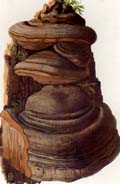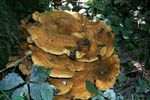 Key to Gilled Mushrooms Key
Key to Gilled Mushrooms KeyThis is a key to gilled mushrooms, that is, mushrooms having a definite cap with a fertile surface consisting of gills. The fruiting body usually also has a stem, although that may be lateral or absent (usually, then, the mushroom is growing from wood). You can use this key to identify mushrooms that you find.
 Polyporaceae Family
Polyporaceae FamilyFertile surface usually a layer of vertical tubes, of which the mouths are visible as pores on the underside of the cap or shelf.
Fruiting bodies usually tougher or harder than the "normal" gilled mushrooms, being leathery, corky, or woody. But they can be quite tender while actively growing
Once grown, they do not decay easily, remaining on the substrate for months or years
They often grow on wood, although a few are terrestrial (even those are usually growing on buried wood)
Fruiting body is usually a flat shelf, or hoof-shaped, protruding directly from the substrate, although sometimes it may have a short stalk.
Some forms never grow away from the substrate at all, so that all that is visible of the fruiting body are the pores.
Sometimes the pores are so minute that the fertile surface seems solid, until you look closely
 Terrestriopolypore Subfamily
Terrestriopolypore SubfamilyGrowing on ground
 Big Terrestriopolypore Tribe
Big Terrestriopolypore TribeLarge (6-18" or more across), compound fruiting body with irregular caps, usually right next to a tree or even surrounding it
Flesh flexible, tough but not hard
 Fewocappus Subtribe
Fewocappus SubtribeFruiting body composed of a few large caps, each larger than a three or four inches across
Phaeolus Genus Patouillard
Diagnosis
- Colorful furry caps and (non-furry) pore surface, darkening to black (and bald) in age
-
Primarily on living conifers, although it will continue to decay them after they have been killed (standing trees, stumps, and logs); rarely on hardwoods
Narrow down your identification:
Phaeolus schweinitziiCap bright orange, yellowish orange, or brownish orange when fresh, darkening to dark brown or black from center or in age. Cap margin usually remains colored
Pore surface greenish yellow at first, darkening similarly
Growth indeterminate; often with sticks and other debris embedded in the fruiting body






 Key to Gilled Mushrooms Key
Key to Gilled Mushrooms Key Polyporaceae Family
Polyporaceae Family Big Terrestriopolypore Tribe
Big Terrestriopolypore Tribe Fewocappus Subtribe
Fewocappus Subtribe




